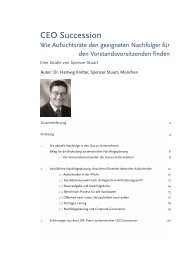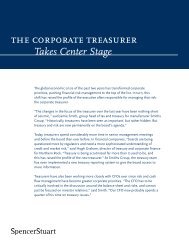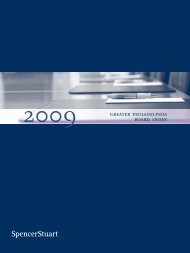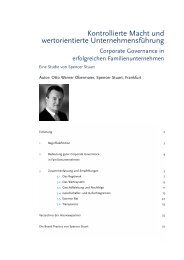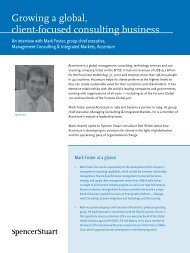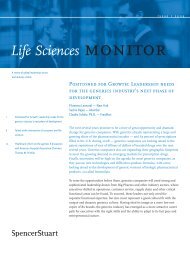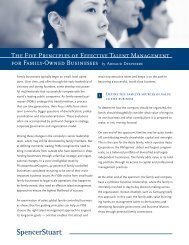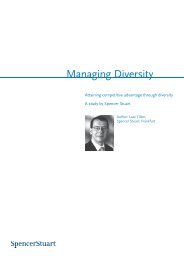Life Sciences Monitor 1.03 - Spencer Stuart
Life Sciences Monitor 1.03 - Spencer Stuart
Life Sciences Monitor 1.03 - Spencer Stuart
Create successful ePaper yourself
Turn your PDF publications into a flip-book with our unique Google optimized e-Paper software.
issue 1 2003<br />
<strong>Life</strong> <strong>Sciences</strong> monitor<br />
a review of global leadership issues<br />
and industry trends<br />
1<br />
7<br />
global trends in pharmaceutical<br />
m&a: the impact on human capital<br />
inside the organization<br />
assisted living: an industry in<br />
transition<br />
Global trends in pharmaceutical M&A: The<br />
impact on human capital inside the organization<br />
Phil Le Goff, <strong>Spencer</strong> <strong>Stuart</strong> – Zurich<br />
John Mitchell, <strong>Spencer</strong> <strong>Stuart</strong> – Atlanta<br />
Pharmaceutical companies — both big and small — are walking a tightrope:<br />
how to continue to develop life-saving treatments while generating the highestpossible<br />
levels of shareholder return. With investors demanding double-digit<br />
increases, coupled with the rising costs of R&D budgets, pharmaceutical companies<br />
are seeking new ways to plug product gaps to achieve expected growth rates. As<br />
a result, M&A activity among the pharmaceutical sector has remained relatively<br />
strong during the economic downturn compared to other industries. Some<br />
speculate it’s become a matter of survival for the major players.<br />
The real changes are taking place inside these organizations as the emergence<br />
of the “superpharma” company shifts the human capital landscape. For example,<br />
the four major pharmaceutical players currently each employ 90,000 people, but<br />
over the next four years, this number is predicted to jump to 200,000 1 . In addition<br />
to the massive consolidation underway, leadership attrition skyrockets to 47 percent<br />
within three years following a merger 2 .<br />
Given these changes, the industry is taking a hard look at the positions and<br />
leadership requirements needed to successfully steer the next generation of<br />
pharmaceutical companies. We spoke with industry experts Neil Anthony, head<br />
of global human resources for Novartis Pharma AG; Don Nelson, head of human<br />
resources for Pfizer’s pharmaceutical business; Michael Pearson, a director in<br />
McKinsey & Company’s healthcare practice; and Joe Riccardo, head of healthcare<br />
investment research for Bear Stearns & Company, for their views on this topic.<br />
1 Delany, Kevin; The Future of Pharma HR 2002<br />
2 Bogan, Christopher and Keith Symmers; “Marriages Made in Heaven,” Pharmaceutical Executive January 2001
<strong>Life</strong> <strong>Sciences</strong> <strong>Monitor</strong><br />
“Given that organizations are growing so quickly, the question remains:<br />
is this productive or counterproductive for our human capital strategy?”<br />
2<br />
motivating factors behind<br />
today’s mega pharma mergers<br />
Today’s pharmaceutical companies are facing a<br />
number of challenges: increased competition from<br />
generics companies, anticipated patent expirations<br />
and a depressed economy. By merging with a midsize<br />
player and creating a superpharma, the organization<br />
has a better opportunity to develop the next<br />
blockbuster product — which allows them to stay<br />
in the big pharma category over the long term.<br />
“All companies need growth for survival,” says<br />
Pearson. “A decade ago, most pharma mergers<br />
were initiated based on impending patent expirations<br />
and anticipated earnings pressures. In order<br />
to sustain positive earnings momentum, they<br />
merged to benefit from opportunities to reduce<br />
costs and help earnings. Today, it’s both about<br />
size, especially on the commercial side, and cost<br />
opportunities.”<br />
“This ‘merger mania’ is driven by the need to<br />
leverage R&D and the sense that sheer scale and<br />
size of sales forces and marketing efforts will be<br />
the determining factor, particularly in the U.S.,”<br />
says Anthony.<br />
“A pharmaceutical company’s survival hinges on<br />
its ability to create new products,” says Riccardo.<br />
“However, the timing and rationale of each merger<br />
depends on the company. In some circumstances,<br />
the CEO is being proactive and strategic. He or<br />
she initiates a merger and/or acquisition if time<br />
is running out on a particular patent or if there is<br />
an opportunity. But in the majority of cases, the<br />
pharmaceuticals need to strengthen their business<br />
and find new synergies.”<br />
“Everyone agrees, for the most part, that the principal<br />
drivers of a merger are to strengthen the<br />
current product portfolio and the R&D pipeline,”<br />
explains Nelson. “However, given that organizations<br />
are growing so quickly, the question remains:<br />
is this productive or counterproductive for our<br />
human capital strategy?”<br />
the human capital challenges<br />
inherent in a mega merger<br />
While the pharmaceutical mega merger may<br />
increase R&D budgets on paper, there are challenges<br />
that all newly merged companies will<br />
need to handle if they hope to reap the long-term<br />
benefits of the deal.<br />
Managing the overall complexity of the organization,<br />
according to Nelson, is an issue. “These<br />
mergers, inherently, create complex organizational<br />
structures and work processes,” he says.<br />
“It’s a result of the sheer size of the new organization.<br />
For example, our research group has<br />
more than doubled in size in less than five years.<br />
So, how do you organize all of those people, get<br />
role clarity and manage complex matrices?”<br />
“For many years, the best R&D groups were from<br />
the small- and mid-size players,” explains Riccardo.<br />
“These organizations were not complex. Rather,<br />
they purposely had small R&D units focused on<br />
very specific objectives. Today’s superpharmas<br />
have to act like the little guys. We’ve observed this<br />
in GlaxoSmithKline’s approach, where they are<br />
replicating what works at companies like Amgen<br />
and Immunex.”
Anthony concurs. “A merger will only be successful<br />
if the company is committed to growing and<br />
enhancing its human capital in the new environment,”<br />
he says. “An assessment of what exactly<br />
you are taking on in terms of people and quality<br />
is rarely a part of merger assessments.”<br />
“You only have partial insight into what you are<br />
getting before the merger closes,” explains Nelson.<br />
“The due diligence completed prior to the announcement<br />
is focused primarily on the financial<br />
implications of the merger and not heavily on<br />
the human capital implications. This is a mistake.<br />
We need to do more during the due diligence<br />
phase to understand the human capital side of<br />
the equation.”<br />
According to Nelson, you also have to understand<br />
whether the company you are buying will deliver<br />
short-term results, long-term results or both, and<br />
make your decisions accordingly. The key is the<br />
ability to make these decisions during the due<br />
diligence phase. This is made difficult by the lack<br />
of information generally available, particularly on<br />
the human capital side, during due diligence.<br />
This added layer of complexity makes producing<br />
early returns — following the merger — even<br />
more difficult to accomplish. “Immediately following<br />
the merger, there is automatic pressure to<br />
show investors and Wall Street that the deal was<br />
a sound business decision,” explains Anthony.<br />
“Focus tends to be, obviously, on cost savings as<br />
a result. Attention is often taken away from the<br />
brands and there is inevitably a period of time<br />
when the organization gets ‘distracted.’ It takes<br />
time to get brand-building back on top.”<br />
managing the obstacles through<br />
restructuring<br />
One of the first steps that a newly merged pharmaceutical<br />
company takes is to restructure the<br />
organization to better manage the complexity<br />
while still being productive. “I firmly believe<br />
that whoever figures out how to organize around<br />
R&D in a large organization,” says Nelson, “and<br />
is able to thoroughly assess the talent they are<br />
getting in the merger — that organization will<br />
have the competitive advantage.”<br />
“To work around the organizational issues, we<br />
have to consider different organizational structures<br />
and rethink the ways we do work,” adds Nelson.<br />
“For instance, there may be cases where breaking<br />
the larger organization into smaller, semi-<br />
autonomous organizations makes sense in terms<br />
of getting clarity of the work process and crispness<br />
and timeliness of decision-making. In such a<br />
regulated industry, however, this has to be balanced<br />
against the need for standardization of many<br />
processes across the corporation. Notice I said<br />
standardization, not centralization.”<br />
The challenge for the larger pharmaceutical<br />
companies is that they have had great success<br />
with a standard business model, according to<br />
Pearson. “In most cases, this consists of centralized,<br />
global functions,” he says. “While some are<br />
experimenting with decentralization, only a few<br />
have adopted this model. What we haven’t seen<br />
are radically different business models within the<br />
industry. Organization innovation is occurring on<br />
the periphery — often with specialty pharmaceutical<br />
companies.”<br />
continued<br />
3
<strong>Life</strong> <strong>Sciences</strong> <strong>Monitor</strong><br />
4<br />
“Traditional drug companies are not the most<br />
efficient operations,” explains Riccardo. “They<br />
have operated for a long time in monopoly situations<br />
that have reaped very high profit margins.<br />
Today, they are facing unprecedented competition,<br />
which is forcing them to find another way<br />
to operate efficiently.”<br />
Similar to the oil industry, which needed to adjust<br />
its business model in the 1970s, the pharmaceutical<br />
industry will need to adjust its cost and<br />
pricing structure accordingly as the price of pharmaceuticals<br />
drop, adds Riccardo. In doing so,<br />
leadership will need to adjust to the new environment,<br />
purposely seeking out those executives<br />
who can drive sales and marketing to propel the<br />
business forward.<br />
assessing your talent<br />
With approximately 80 percent of employees<br />
stating that senior management cares more<br />
about the bottom line than the quality of the<br />
product or the people, following the merger,<br />
it is imperative that leadership does not overlook<br />
its talent. 3 While restructuring the organization<br />
in an effort to overcome the chaos is needed,<br />
so is properly assessing the people in those<br />
structures. “Understanding the cultural fit of<br />
the talent that you are acquiring and how that<br />
talent fits in with the restructured organization<br />
is critical,” says Anthony.<br />
“We’re definitely seeing a better assessment of<br />
human capital following a merger, but there is<br />
still much room for improvement,” says Nelson.<br />
“We need to continue to find ways to assess the<br />
3 Bogan, Christopher and Keith Symmers; “Marriages Made in Heaven,” Pharmaceutical Executive January 2001<br />
talent prior to engaging in the merger/acquisition.<br />
However, this is not always easy to accomplish.”<br />
The primary source of information about the<br />
talent comes from the current management<br />
team — those executives who, understandably,<br />
are trying to save the jobs of their team members.<br />
To counteract this problem, Nelson recommends<br />
that the acquiring organization minimize the<br />
dependence on information received from<br />
current management and maximize the use of<br />
information about historical performance.<br />
“Because,” as he points out, “once senior<br />
management is committed to the acquisition,<br />
they will likely remain committed, no matter<br />
the situation or discoveries.”<br />
searching for the ideal leadership traits<br />
There are no hard and fast rules regarding the<br />
executive leadership characteristics needed to<br />
successfully manage a newly merged pharmaceutical<br />
company. Those traits often depend on<br />
the personality and the culture of the organization.<br />
However, there are common themes and skillsets<br />
that have been proven highly effective in this<br />
ever-changing climate.<br />
1. External experience in a complex environment<br />
“Senior executives from the industrial sector may<br />
be best equipped to run these new organizations,”<br />
says Riccardo. “They have first-hand experience in<br />
an ever-changing environment and they have seen<br />
their stock prices fall apart. While it isn’t easy, the<br />
pharmaceutical industry needs executives who<br />
can adjust to new ways of thinking and are able<br />
take a hard look at productivity.”
In addition to those executives with industrial<br />
sector experience, executives from the consumer<br />
goods and services industry — people who can<br />
manage large, global brands and possess a strong<br />
understanding of a sophisticated selling matrix<br />
— also are highly attractive, according to Anthony.<br />
“For many staff support functions, they do not<br />
need to have any experience in life sciences,”<br />
adds Nelson, “so the industry does not matter<br />
as much. However, there is no way we could go<br />
outside of the industry for some specific skillbased<br />
jobs, such as a disease category specialist.”<br />
2. Industry insiders with strong management<br />
background<br />
As Nelson explains, while outsiders can bring<br />
attractive qualities, there are many times when<br />
industry insiders are required. Pearson believes<br />
that successful pharmaceutical executives need<br />
to have a strong scientific understanding,<br />
especially in the area of products. “The success<br />
rate for outsiders coming in is quite low,” he<br />
says. “However, with insiders, often the general<br />
management experience comes quite late in their<br />
careers. The pharma industry has the reputation<br />
of attracting great talent, but often focuses this<br />
talent in specialized areas without exposing<br />
younger executives to situations where they can<br />
develop more broad-based managerial skills. To<br />
stay competitive, companies will need to speed<br />
this up — familiarize younger talent to the<br />
different functional areas earlier in their careers.”<br />
“However, with insiders, often the general management<br />
experience comes quite late in their careers.”<br />
3. Personality matters<br />
The competitiveness of the pharmaceutical<br />
industry has only intensified as a result of the<br />
mega mergers. At Novartis, as with most<br />
organizations, the culture prescribes the type<br />
of personality required to successfully navigate<br />
the company.<br />
“While we look for executives with multi-faceted<br />
backgrounds, we’re also searching for top performers<br />
who understand how to work through a<br />
complicated matrix,” Anthony explains. “This<br />
type of person often possesses a competitive edge<br />
and a certain level of intensity. They also must<br />
be focused on being innovative in a team environment<br />
— a combination that is not always easy<br />
to find. And finally, because of our pricing and<br />
margin pressures, everyone must be 100 percent<br />
focused on beating the competition. That was<br />
not always the case in the past within the industry.”<br />
looking to the future<br />
There are no signs that the pharmaceutical consolidation<br />
flurry is ending. Pearson predicts that<br />
in the coming years, we will see fewer than six<br />
major pharmaceutical players. Mid-sized companies<br />
will be pushed out, with only the smallersized<br />
companies remaining.<br />
“The only constant in this industry is change itself,”<br />
says Riccardo. “Today’s changes are being stimulated<br />
by new forces — states, federal government,<br />
competition — with generic companies winning<br />
patent disputes 75 percent of the time. In order to<br />
remain successful, companies are going to have<br />
continued<br />
5
<strong>Life</strong> <strong>Sciences</strong> <strong>Monitor</strong><br />
6<br />
to learn how to live and be productive. This will<br />
take some adjustment in terms of management,<br />
culture and operations of today’s drug companies.”<br />
Successful leaders of a mega pharmaceutical<br />
company will be able to run a complex, decentralized<br />
organization — that shares a common<br />
purpose — through motivation. The most effective<br />
leaders will accomplish this by building trust<br />
amongst the different arms of the company<br />
through constant and open communication;<br />
about the authors<br />
Phil Le Goff is the European <strong>Life</strong> <strong>Sciences</strong> Practice<br />
Leader for <strong>Spencer</strong> <strong>Stuart</strong>. He has 25 years of corporate<br />
experience in the healthcare sector and has held senior<br />
positions in general management, sales and marketing,<br />
and research and development within the pharmaceutical<br />
and medical device arenas.<br />
Prior to joining <strong>Spencer</strong> <strong>Stuart</strong>, Phil served as group<br />
president of vascular and non-vascular businesses at<br />
Boston Scientific Corporation in the U.S. Prior to<br />
that, he was head of strategy and public affairs and a<br />
member of the global executive committee at Novartis<br />
Pharma in Basel, Switzerland. Phil previously had spent<br />
13 years with Sanofi-Synthelabo, where he served in<br />
several senior positions, including CEO of Sanofi North<br />
America in New York and worldwide president of the<br />
bio-industries division in Paris. He began his career<br />
with Ciba-Geigy, where he held positions of increasing<br />
responsibility in Switzerland, Brazil and the U.K. In<br />
addition, he has served on the boards of several international<br />
organizations, including the council of the<br />
International Federation of Pharmaceuticals Manufacturers’<br />
Associations (IFPMA) in Geneva and the policy<br />
board of The Centre for Medicines Research (CMR)<br />
in London.<br />
setting the moral tone of the organization; and<br />
identifying and empowering those in the organization<br />
who also can drive the business. By honing<br />
these skills, today’s superpharma executives will<br />
be better equipped to walk the tightrope: to lead<br />
their organizations as they search for new treatments<br />
and products that generate the highestpossible<br />
returns for shareholders. <br />
John Mitchell is the North American <strong>Life</strong> <strong>Sciences</strong><br />
Practice Leader for <strong>Spencer</strong> <strong>Stuart</strong>. In addition, he<br />
leads the global Pharmaceutical Specialty Practice,<br />
coordinating with more than 100 colleagues in the<br />
global <strong>Life</strong> <strong>Sciences</strong> Practice. He has 25 years of<br />
experience in the industry and executive search,<br />
focused exclusively in life sciences/healthcare.<br />
John is a former partner with another leading international<br />
executive search firm, where he served as the<br />
managing partner of its life sciences practice. He<br />
also served on that firm’s board of directors. Before<br />
entering the search profession, John was a senior vice<br />
president of Efficient Health Systems, one of the fastest<br />
growing cost management/utilization review organizations<br />
in the managed care industry. Earlier in his career,<br />
he served as vice president and area manager of American<br />
Hospital Supply Corporation, becoming the youngest<br />
company officer elected in the history of this marketleading<br />
company. His functional experience has included<br />
general management, marketing and sales, strategic<br />
planning and business development.
Assisted living: An industry in transition<br />
Ronald Zera, <strong>Spencer</strong> <strong>Stuart</strong> – Dallas<br />
Karine Gill, <strong>Spencer</strong> <strong>Stuart</strong> – Miami<br />
In the late 1980s, as the parents of the baby boomers neared retirement, there was an accelerated<br />
demand for assisted living facilities that could handle their daily living needs without having to enter<br />
a nursing home. Assisted living was designed to provide long-term supportive care for chronically,<br />
but not acutely ill elderly. The premise was to allow for the elderly to gain an ability to live a more<br />
autonomous lifestyle, while enjoying the comfort and security of on-site services. Now, almost 20<br />
years after its introduction and on the cusp of another demographic influx, the industry is in throes<br />
of monumental change.<br />
To further explore the implications of this evolving<br />
industry, we spoke with Jeff Ferguson, recently<br />
appointed president of management and operations<br />
for Erickson Retirement Communities, formerly<br />
with Marriott Senior Living Services Division;<br />
John Hopkins, chief operating officer and president<br />
of Benchmark Senior Living; Werner Neuteufel,<br />
president and COO of Atria; and Mark<br />
Pacala, a venture partner in Essex-Woodlands<br />
Health Ventures, L.P.<br />
changing demographics<br />
By 2030, it is predicted that the number of Americans<br />
who are age 65 or older will make up 20<br />
percent of the populace. And in Europe, by 2050,<br />
nearly half of its entire population could be over<br />
the age of 60. There are a number of reasons for<br />
this trend. Advances in nutrition and medical<br />
science are increasing life expectancy, especially<br />
throughout Europe and North America. The<br />
nuclear family also is changing. With more<br />
women entering the workforce, the primary caregivers<br />
for elderly parents are less available. In addition,<br />
the average U.S. family moves every five<br />
years — taking them further away from relatives.<br />
As a result, there is an increasing number of elderly<br />
who are not sick enough for nursing homes,<br />
yet are too old to live alone. Both the healthcare<br />
and hospitality industries have become instrumental<br />
in the growth of assisted living facilities. But<br />
what can each industry learn from one another’s<br />
best practices to enhance the sophistication of the<br />
relatively new industry? And more importantly,<br />
what type of executive will be needed to lead an<br />
assisted living organization through increased<br />
customer demand and government regulations?<br />
hotel operators transition into healthcare<br />
After 10 years of running Omni, Hopkins decided<br />
it was time for a change. Having spent his entire<br />
career exclusively in the hotel business, he was<br />
persuaded to invest in an assisted living community.<br />
Two years later, Hopkins now is the<br />
chief operating officer and president of Benchmark<br />
Senior Living, the fastest-growing provider<br />
of senior housing in the Northeast.<br />
Many executives from the hospitality industry<br />
have transitioned into assisted living. Neuteufel<br />
joined the industry for professional and personal<br />
reasons. “It was, and is, an industry of rapid<br />
growth and development,” he says, “allowing me<br />
7
<strong>Life</strong> <strong>Sciences</strong> <strong>Monitor</strong><br />
“Some of the hospitality expertise transfers well to assisted living, but a<br />
lot of the core fundamentals of the day-in, day-out operations do not.”<br />
8<br />
the opportunity to apply my knowledge and<br />
experience to let me start a ‘new’ career in a<br />
field where I could truly make a difference —<br />
running a company and having the chance to<br />
enhance the lives of older people.”<br />
Pacala also wanted a change. “As a consultant<br />
for Booz Allen’s healthcare strategy practice, I<br />
was appalled at the quality of service execution<br />
within healthcare,” he recalls. “I joined Marriott<br />
to see how the best service companies in the<br />
world maintain a relentless focus on the customer.<br />
In other words, I wanted to learn how to recruit<br />
and motivate the hourly service worker all the<br />
while intending to incorporate these learnings<br />
into healthcare.” Pacala now works with existing<br />
assisted living companies to figure out how to<br />
either improve their operational execution or<br />
come up with a transactional strategy.<br />
healthcare versus hospitality<br />
Given that many hospitality executives are<br />
moving into the assisted living industry, is it<br />
safe to assume that the hotel industry is taking<br />
the lead in transforming this industry? If so,<br />
what is the role of the healthcare professional?<br />
“While there are clearly technical differences<br />
between hospitality and assisted living, I was<br />
surprised at the extent at which similarities did<br />
occur,” Hopkins says. “One does not necessarily<br />
need to be a healthcare professional to succeed.<br />
However, one must certainly surround themselves<br />
with direct care experts. Hospitality is a real<br />
estate-based service industry, as is this one. It<br />
is very capital intensive and very labor intensive.<br />
They are both operating businesses, with similar<br />
functional disciplines: accounting, sales, marketing,<br />
human resources, food and beverage. But<br />
while the hospitality industry has been around<br />
for a long time, this industry is very immature.”<br />
“Some of the hospitality expertise transfers well<br />
to assisted living,” counters Pacala, “but a lot of<br />
the core fundamentals of the day-in, day-out<br />
operations do not.”<br />
“As to which industry has the advantage, it’s<br />
really a toss up,” explains Ferguson. “I don’t<br />
think that if you are a natural in the hospitality<br />
industry that it’s an easy transition into assisted<br />
care. Food service and housekeeping skills do,<br />
but there are core fundamentals that do not.<br />
However, if you have a healthcare background,<br />
it’s a big jump as well. So while it draws aspects<br />
from each, assisted living requires an unusual<br />
skill-set with a high degree of flexibility.”<br />
what the industries learn from one another<br />
But to succeed in the relatively new industry,<br />
best-in-class executives acknowledge that assisted<br />
living operators would do well to adopt the best<br />
practices from both industries rather than focus<br />
on only one set of experiences. Hospitality executives<br />
bring operational and business experience<br />
while healthcare professionals understand the<br />
medical and regulatory issues.<br />
“Creating conventional operating performance<br />
metrics at all levels is something that hospitality<br />
experts offer assisted living,” explains Pacala.<br />
“This sounds pretty simple, but metrics were not
commonplace in the retirement industry until<br />
the mid-1990s. When we provided our managers<br />
with performance expectations around productivity<br />
measurements we were able to compare property<br />
to property against those measures. You wouldn’t<br />
believe how quickly performance improved.”<br />
In addition to performance metrics, hospitality<br />
executives also provide operational and real<br />
estate experience. “The genesis of the assisted<br />
living industry was formulated on the altruistic<br />
basis of providing care to seniors,” says Hopkins.<br />
“While this is a necessary ingredient, once<br />
institutional investors entered the sector, the<br />
demand for performance metrics and executive<br />
talent became far greater. Many young companies<br />
have been forced by investor sophistication to<br />
look outside to find leaders who understand<br />
metrics, real estate and service and who can lead<br />
an industry whose success is based upon a wide<br />
spectrum of skill levels of employees.”<br />
“Marriott’s initial strategies in the mid- to late-<br />
1980s were fundamentally sound,” says Pacala.<br />
“There were cross-over aspects from hotels:<br />
property location placement, reception, hospitality,<br />
food service, maintenance, what goes on behind<br />
the scene. However, you still have to understand<br />
the healthcare components: regulation, the<br />
service execution, the kind of psychology of the<br />
professional caregivers, the nursing assistant.”<br />
“Healthcare providers understand the regulatory<br />
aspects of the business,” explains Neuteufel.<br />
“When I entered the assisted living industry<br />
from hospitality, I found myself with a big<br />
learning curve. Also, executives with healthcare<br />
experience have built the necessary networks<br />
that enable them to more actively identify the<br />
track of the medical profession and innovations<br />
and how they will influence the assisted living<br />
industry.”<br />
the ideal executive<br />
Is there such thing as an ideal executive for an<br />
industry undergoing vast changes?<br />
“Minimally, assisted living executives should have<br />
a bachelor’s degree in business, or even better,<br />
an M.B.A.; 10 years of experience in a servicerelated<br />
industry; and somebody with a passion<br />
for good customer service,” says Neuteufel. “It<br />
does not matter where they come from, but they<br />
have to be customer oriented with a love for our<br />
seniors.”<br />
“At Marriott, our executive team was a mixture<br />
of people with both healthcare and hospitality<br />
backgrounds,” says Ferguson. “I was very proud<br />
of the caliber of our executive team. Our industry,<br />
however, needs more people who have experience<br />
in healthcare. Take the CFO. Our broad portfolio<br />
mix required that we have someone who understood<br />
the reimbursement environment since we<br />
did some business with Medicare and Medicaid.<br />
Our prior CFO had no background in healthcare.<br />
It made the job extremely difficult for him and<br />
problematic for the business unit.”<br />
For Pacala, his executive team captures the best<br />
of both worlds. “We recruited people from the<br />
service healthcare industry and from outside,”<br />
he explains. “You need to have some proficiency<br />
and experience that is deep-seeded in healthcare<br />
continued<br />
9
<strong>Life</strong> <strong>Sciences</strong> <strong>Monitor</strong><br />
10<br />
and you need executives from a range of<br />
industries to broaden the perspective and<br />
hopefully infuse non-healthcare business<br />
elements into the industry.”<br />
challenges facing assisted living<br />
The biggest obstacle today faced by assisted<br />
living operators is regulation — both on a state<br />
and national level. “I fear our industry will<br />
become over-regulated, which is exactly what<br />
happened to skilled nursing,” explains Hopkins.<br />
“While we are a for-profit company, we also<br />
recognize that we have to do what is right for the<br />
residents. And if the industry does what is right,<br />
it shouldn’t be in opposition to making a profit<br />
and should mitigate the need for excessive<br />
government oversight.”<br />
“The greater the intrusion of government into<br />
the business, the more difficult it will be for<br />
providers to be creative in the ways they satisfy<br />
customer needs,” says Ferguson. “I have seen<br />
how regulation doesn’t really sync in with what<br />
the customer wants. I know that the government<br />
is going to be intrusive, but I would like to<br />
minimize their encroachment. They will not only<br />
destroy the economics, but it will change the<br />
whole flavor of the environment for the<br />
customer; it will make it more institutional.”<br />
looking towards the future<br />
Despite fears of government regulation and<br />
insurance costs, assisted living business leaders<br />
believe in the industry’s growth potential. “It is<br />
just a matter of time,” says Neuteufel. “The<br />
emergence of assisted living that took place<br />
15 years ago was, unfortunately, 20 to 25 years<br />
early — given the changing demographics. It’s<br />
soon going to be a huge industry.”<br />
And according to Pacala, the industry needs to<br />
prepare for tomorrow by doing three things today:<br />
rigorously operate around a tightly defined<br />
customer focus, instill a sense of excitement<br />
within the team, and hold firm to simple,<br />
conventional operating performance metrics.
about the authors<br />
Ronald Zera has been involved in executive search<br />
for more than 20 years, specializing in the <strong>Life</strong> <strong>Sciences</strong><br />
Practice of the firm since 1993. At <strong>Spencer</strong> <strong>Stuart</strong>, he<br />
has worked with search committees in academic<br />
departments, integrated healthcare delivery systems,<br />
HMOs, emerging biotechnology companies, managed<br />
care groups, drug discovery endeavors and medical<br />
device manufacturers.<br />
Ron has developed the candidate specification and<br />
conducted the recruiting for senior managers, physicians<br />
and scientists in well-established public companies as<br />
well as in startup firms. The engagements have called<br />
for experience in understanding the position of the firm<br />
and its need for continuity or its need for transition to<br />
new functions. He has responded to companies<br />
requesting “visionaries,” “world-class authorities,”<br />
“technocrats” and “seasoned executives.”<br />
Prior to entering executive search, Ron was associate<br />
dean at Iowa State University before beginning his work<br />
in professional placement for Frito-Lay (PepsiCo) and<br />
Nucor Corporation. He serves on the President’s<br />
Research Council at the University of Texas Southwestern<br />
Health <strong>Sciences</strong> Center, the board of Hope Cottage and<br />
the board of the Center for Research Management.<br />
Karine Gill, based in Miami, leads <strong>Spencer</strong> <strong>Stuart</strong>’s<br />
Hospitality & Leisure Specialty Practice and takes<br />
an active role in search assignments in the hotel,<br />
restaurant, cruise line, gaming and timeshare<br />
industries on a global basis. Clients include Fortune<br />
500 companies as well as high-potential emerging<br />
startups and turnaround companies. As a member<br />
of the firm’s broader Consumer Goods & Services<br />
Practice, Karine has immediate access to talent and<br />
resources in that area.<br />
Prior to joining <strong>Spencer</strong> <strong>Stuart</strong>, Karine was managing<br />
director for a boutique executive search firm that<br />
specialized in the hospitality, leisure and gaming<br />
industries throughout the Americas. Prior to this role,<br />
she was vice president of sales for the Exclusive Division<br />
of Forte Hotels in New York, and formerly held senior<br />
positions with the ITT Sheraton Corporation, most<br />
notably in the U.S., Europe, Latin America and the<br />
Caribbean.<br />
A native of Antwerp, Belgium, Karine graduated from<br />
the University of Louvain (Belgium) with a master’s<br />
degree in applied economics. She is fluent in English,<br />
French, Dutch and Spanish, and has a working<br />
knowledge of German and Italian.<br />
11
<strong>Life</strong> <strong>Sciences</strong> <strong>Monitor</strong><br />
spencer stuart’s life sciences practice<br />
The executive search firm of choice for top-level<br />
life sciences assignments, <strong>Spencer</strong> <strong>Stuart</strong> is the<br />
only firm with a fully integrated <strong>Life</strong> <strong>Sciences</strong><br />
Practice, placing executives in a wide array of<br />
functions in every sector of the industry. Our<br />
global practice comprises a network of more<br />
than 45 consultants — each of whom has seniorlevel<br />
management experience in the life sciences.<br />
In addition to our executive search work, we<br />
have placed directors on the boards of many<br />
leading life sciences companies and regularly<br />
act as consultants for our clients on a number<br />
of ongoing human capital-related issues.<br />
about spencer stuart<br />
<strong>Spencer</strong> <strong>Stuart</strong> is the foremost privately held,<br />
global executive search firm, spanning over 50<br />
offices in 25 countries worldwide. Since 1956,<br />
we have been providing select clients with a<br />
range of human capital solutions, including<br />
senior-level executive search, board director<br />
appointments, strategic leadership services and<br />
middle-management recruiting. We conduct<br />
nearly 4,000 assignments each year, partnering<br />
effectively with clients ranging from the Fortune<br />
500, to mid-cap, to emerging growth companies<br />
across a broad range of industries and sectors.<br />
12<br />
for more information<br />
To request additional copies of the <strong>Life</strong> <strong>Sciences</strong> <strong>Monitor</strong><br />
or copies of our recent intellectual capital, please contact<br />
Kelley Allen at 312.822.0088 or kallen@spencerstuart.com.<br />
The <strong>Life</strong> <strong>Sciences</strong> <strong>Monitor</strong> is a publication of<br />
<strong>Spencer</strong> <strong>Stuart</strong>’s <strong>Life</strong> <strong>Sciences</strong> Practice.<br />
© <strong>Spencer</strong> <strong>Stuart</strong>, 2003<br />
Amsterdam<br />
Atlanta<br />
Barcelona<br />
Beijing<br />
Bogota<br />
Boston<br />
Brussels<br />
Budapest<br />
Buenos Aires<br />
Chicago<br />
Dallas<br />
Dusseldorf<br />
Frankfurt<br />
Geneva<br />
Hong Kong<br />
Houston<br />
Johannesburg<br />
Leeds<br />
London<br />
Los Angeles<br />
Madrid<br />
Manchester<br />
Melbourne<br />
Mexico City<br />
Miami<br />
Milan<br />
Minneapolis/St. Paul<br />
Montreal<br />
Munich<br />
New York<br />
Orange County<br />
Paris<br />
Philadelphia<br />
Prague<br />
Rio de Janeiro<br />
Rome<br />
San Francisco<br />
San Mateo<br />
Santiago<br />
Sao Paulo<br />
Shanghai<br />
Singapore<br />
Stamford<br />
Stockholm<br />
Stuttgart<br />
Sydney<br />
Tokyo<br />
Toronto<br />
Vienna<br />
Warsaw<br />
Washington, D.C.<br />
Zurich<br />
www.spencerstuart.com



